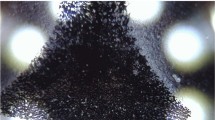Abstract
Recent work using a number of experimental techniques has shown that simple Newtonian liquids can slip against very smooth, lyophobic surfaces. Most previous work has examined lyophobic surfaces produced by forming self-assembled monolayers on smooth substrates. However it has also been shown that octadecanoic (stearic) acid solution in hydrocarbon can promote slip of the liquid against smooth surfaces. This raises the intriguing possibility that one mechanism of action of organic friction modifier additives may be to promote slip in hydrodynamic contacts and thus reduce friction. To test this conjecture, experiments have been carried using a low-load, hydrodynamic friction tester in which a glass cylinder is loaded against a very smooth sapphire flat which has been previously immersed in stearic acid solution. The contact is supplied with a solution of stearic acid in hexadecane and the glass cylinder is rotated at a speed sufficient to generate a full hydrodynamic film. It is found that this system gives significantly lower friction than when using hexadecane alone or when the sapphire is slightly roughened. The results are consistent with the occurrence of liquid slip at the sapphire surface.






Similar content being viewed by others
References
Eng Patent 130,677
Wells, H.M., Southcombe, J.E.: The theory and practice of lubrication: the 'germ' process. J. Soc. Chem. Ind. 39, 51T–60T (1920)
Langmuir, I.: The mechanism of the surface phenomena of flotation. Trans. Farad. Soc. 15, 62–74 (1920)
Desvaux, H.: Le frottement des solides: epaisseur minimum d'un enduit lubrefiant. J de Phys et la Radium 5, 845 (1924)
Hardy, H.B., Doubleday, I.: Boundary lubrication - the paraffin series. Proc Roy Soc Lond A100, 550–757 (1922)
Bowden, F.P., Leben, L.: The Friction of Lubricated Metals. Phil Trans Roy Soc A239, 1–27 (1940)
Trillat, J.J.: The Adsorption of Oils in Relation to Lubrication. I Mech E Proceedings of the General Discussion on Lubrication and Lubricants 2, 55–59 (Oct 1937)
Deryaguin, B.V., Karassev, V.V., Zakhavaeva, N.N., Lazarev, V.P.: The Mechanism of Boundary Lubrication and the Properties of the Lubricating Film. Short- and Long-Range Action in the Theory of Boundary Lubrication. Wear 1, 277–290 (1957/58)
Smith, A.J., Cameron, A.: Rigid Surface Films. Proc Roy Soc Lond A328, 541–560 (1972)
Hersey, M.D.: Logic of oiliness. Mech Eng 15, 561–566 (1933)
Hersey, M.D.: Theory of Lubrication, J Wiley and Sons Inc, New York (1936)
Spikes, H.A.: Boundary lubrication and boundary films. Proc 19th Leeds-Lyon Symposium on Tribology, Leeds, Sept 1992: Thin Films in Tribology, 331–346 (1993)
Anghel, V., Bovington, C., Spikes H.A.: Thick film formation by friction modifier additives. Lubr Science 11, 313–335 (1999)
Baudry, J., Charlaix, E., Tonck, A., Mazuyer, D.: Experimental Evidence for a Large Slip Effect at a Nonwetting Fluid-Solid Interface. Langmuir 17, 5232–5236 (2001)
Craig, V.S.J., Neto, C., Williams, D.R.M.: Shear-dependent Boundary Slip in an Aqueous Newtonian Liquid. Phys Rev Lett 87, 054504 (2001)
Zhu, Y., Granick, S.: Rate Dependent Slip of Newtonian Liquid at Smooth Surfaces. Phys Rev Lett 87, 096105 (2001)
Zhu, Y., Granick, S.: Limits of Hydrodynamic No-slip Boundary Condition. Phys Rev Lett 88, 106102 (2002)
Tretheway, D.C., Meinhart, C.D.: Apparent Fluid Slip at Hydrophobic Microchannel Walls. Phys of Fluids 14, L9 (2002)
Pit, R., Hervet, H., Leger, L.: Friction and Slip of a Simple Liquid at a Solid Surface. Tribology Letters 7, 147–152 (1999)
Pit, R., Hervet, H., Leger, L.: Direct Evidence of Slip in Hexadecane: Solid Interfaces. Phys Rev Lett 85, 980–983 (2000)
Zhu, Y., Granick, S.: No-Slip Boundary Condition Switches to Partial Slip When Fluid Contains Surfactant. Langmuir 18, 10058–10063 (2002)
Spikes, H.A.: The half-wetted bearing. Part I: extended Reynolds equation. Proc I Mech E Part J 217, 1–14 (2003)
Choo, J.H., Spikes, H.A., Ratoi, M., Glovnea, R.P., Forrest A.: Friction reduction in low-load, hydrodynamic lubrication with a hydrophobic surface. Trib Intern 40, 154–159 (2007)
Choo, J.H., Glovnea, R.P., Forrest, A.K., Spikes, H.A.: A low friction bearing based on liquid slip at the wall. ASME Trans J of Trib 129(3) (2007)
Acknowledgement
We thank the Engineering and Physical Sciences Research Council (EPSRC), United Kingdom, for funding this research.
Author information
Authors and Affiliations
Corresponding author
Rights and permissions
About this article
Cite this article
Choo, JH., Forrest, A.K. & Spikes, H.A. Influence of Organic Friction Modifier on Liquid Slip: A New Mechanism of Organic Friction Modifier Action. Tribol Lett 27, 239–244 (2007). https://doi.org/10.1007/s11249-007-9231-z
Received:
Accepted:
Published:
Issue Date:
DOI: https://doi.org/10.1007/s11249-007-9231-z




